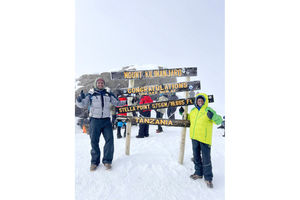THE SOJOURNER : Of Man-eating Lions and ‘Lambalambas’

What you need to know:
- When lions cannot find food, they are forced to walk over many miles. In desperation, they turn to livestock or humans for survival.
When one talks of man-eating lions, one’s memory automatically recalls the legendary Tsavo cats, which many years ago ravaged Kenya. These lions killed and munched about 140 railroad workers there.
This was in the late 1890s, at the time when the historical railway line from Mombasa to Uganda was being laid. Indeed it is a known fact that many deaths by big cats have been caused by lions in particular. According to scientific research, what drives a lion to kill humans is lack of prey.
When lions cannot find food, they are forced to walk over many miles. In desperation, they turn to livestock or humans for survival.
Ironically it is basically human activity, which is responsible for declining prey populations. The infringement of lion territory by humans cause lions to run out of places to hunt. It is also argued that human beings are easy prey to catch, which naturally appeals to old and sick lions.
Notwithstanding this scientific point, the Tsavo man-eating lions had their sights on the railroad crew. One possible explanation for this is that the lions got a taste for human blood after scavenging on the corpses of workers.
Many of these men were basically slaves and were not given proper burial thus leaving their bodies exposed to lions. This opportunity enhanced the lions’ taste for human flesh and they proceeded to attack the living as well. But that is a story for another day.
Like many other East Africans who grew up reading narratives of the Tsavo man-eaters, I ended up believing that that was the greatest lion-caused tragedy in this part of Africa. And how wrong I was.
It took a good friend of mine, a former co-worker, and not even a Bongolander - he is from Sudan - to point out that actually a greater lion-caused tragedy took place in Bongoland. To be more precise in my very own home district, Njombe, almost a century ago
Abdulhamid Sheikh, that is his name, had just read my piece on 2 February this year in this very same paper, on the tragedy of ‘Lambalambas’ in Benaland. And he suddenly realised that I originally come from Njombe.
This knowledge tinkled in his mind. He recalled, as a semi-professional hunter, he had read something about man-eating lions of Njombe, and how they terrorised the Benas. He advised me to read the book by George Bushby on the tragedy. I have to admit I have only read a review of the book.
The book narrates how a pride of lions unleashed a reign of terror during which hundreds of ‘natives’ were killed and devoured. Actually about 250 were killed in and around Wanging’ombe. The total, including victims from surrounding villages, comes to over 1,500. Tragically and typical of the era, which suprisingly is still the case today, superstition, witchcraft and sorcery were deemed to be the root causes of this tragedy.
The residents alleged that a ‘Lambalamba’, one Matamula Mungerea, wanted to avenge following a local dispute and thus invoked an evil spell in the form of the man-eating lions.
What they did not know was that between 1932 and 1947, when lions killed and fed on these hapless Benas, the British colonial government put in place a rinderpest virus control programme.
In their ‘good’ intention to eradicate the virus they began killing wild animals like zebra, wildbeest and antelope. Subsequently, the lions began to starve and search for alternative prey.
It is documented that one pride of 15 lions was especially violent, earning them the name of ‘Man-eaters of Njombe.’ Allegedly, the Njombe lions were very clever, moving through the night and killing during the day. Eventually, after devouring more than 1,500 humans, the lions were exterminated by the colonial game wardens.
As stated in my previous pieces, it is quite sickening to learn that the ‘Lambalambas’ have been a force to reckon with in my district, and Bongoland, for more than a century. Indeed, this is very disheartening.
The author is a veteran journalist and communication expert based in Arusha




